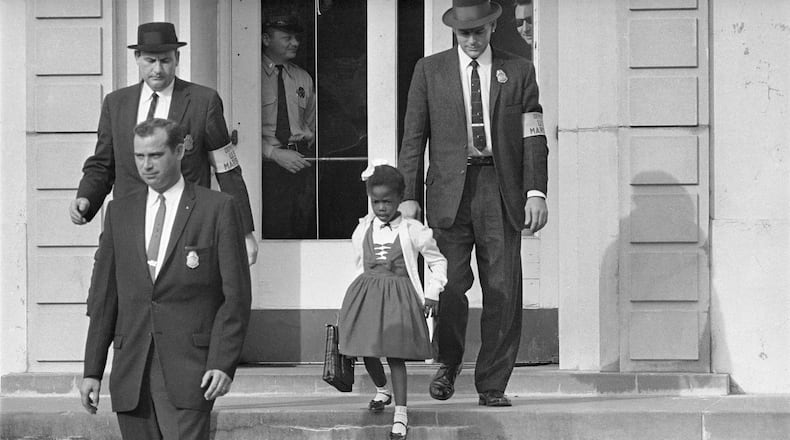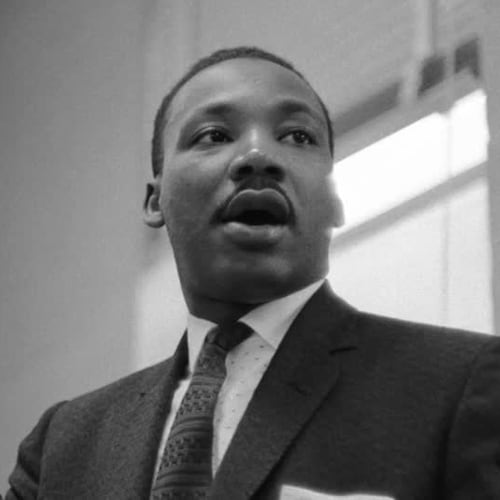This story was originally published in 2022. For our complete Black History Month coverage, click here.
To get to school in the morning, Ruby Bridges walked through a crowd of hateful people shouting threats and curses.
It was a terrible gantlet for a 6-year-old girl.
What is sometimes not mentioned in stories about Ruby, who, in 1960, became the first Black child to integrate the William Frantz Elementary School in New Orleans, is the eerie silent world she encountered on the other side of that mob.
She was taught in an otherwise empty classroom. She was the only student. Her teacher was Barbara Henry, a Boston native who was the only member of the staff willing to accept a Black student.
While most white parents had pulled their children out of the school, a few violated the boycott, and sent the young ones back in the following days. The white students were kept apart from Ruby, but every now and then she would hear the sound of young voices.
“I would mention it to Mrs. Henry,” Ruby Bridges Hall said in an interview from 2018 with the Norman Rockwell Museum. “I’d say ‘Mrs. Henry I hear kids!’ And she would never say anything.”
That strange limbo finally ended when her teacher, aware the principal was illegally keeping the white students separate, insisted they be allowed to see one another.
The solitary confinement that marked Ruby’s first year at school passes understanding, said Nicole Moore, director of education at the Center for Civil and Human Rights.
Moore said: “You can’t look forward to sitting next to your friend because there is no friend to sit next to. No recess. An essential part of her childhood experience was taken from her.”
Ruby wasn’t the only Black child integrating white schools in New Orleans that year, but she went through her experience alone.
Credit: AP
Credit: AP
Sybil Morial, who turns 90 this year, was a young mother in 1960, married to the attorney Ernest “Dutch” Morial, who had filed the lawsuit compelling New Orleans to comply with 1954′s Brown V. Board of Education. (Later Ernest would become New Orleans’ first Black mayor.)
Their children integrated a Catholic school in New Orleans, and Sybil Morial said “years later they told me some of the things they had to hear. They had to run home sometimes, or take another route home.”
Was it traumatic for them? “They said to me it made them strong.”
In interviews, Ruby Bridges Hall often downplays the emotional impact of her experiences as a 6-year-old. (She has said the crowds of protesters on the street outside her school reminded her of Mardi Gras.)
But former Ambassador Andrew Young’s 2009 documentary film, “How We Got Over,” offers a clear image of the times.
In the film, Young interviews Ray Moore, who at the time was WSB television news director, and includes some footage from Moore’s contemporaneous reports out of New Orleans.
In a news report from in front of Ruby’s school, Moore tells the camera: “One woman’s mouth twisted as she saw a little six-year-old Negro child, a white bow in her hair, walk into William Frantz school this morning. The woman said ‘Look at that black slimy thing.’”
Years later, Young caught up with Moore, who explained that, as news director, he assigned himself the story in New Orleans on purpose.
“I sent myself,” he told Young, “because I wanted this community to face up to desegregation.”
When Moore recalled the scene in New Orleans, his memories were even more chilling than the television segments. “Some of the white women were saying ‘Spit on her! Spit on her!’ as that little Black child went by,” he told Young, “and some of them did spit on her. And the names they called and all the gosh-awful nasty things they did were really revolting.”
Robert Coles, author and Harvard professor who in 1960 had just finished serving in the Army as a military psychologist, observed the events in New Orleans, and they changed the course of his life.
He offered to provide counseling to Ruby and her family and met with them many times over the course of the next year. He wrote extensively about the children of the Civil Rights movement in “Children of Crisis” and “The Spiritual Life of Children,” and eventually wrote the children’s book “The Story of Ruby Bridges,” contributing the proceeds to the Ruby Bridges Foundation.
In an interview from the time period, Coles recalls an incident he has recounted many times. Ruby’s teacher tells him she has seen Ruby pause on the stairs of the school and speak to the protesters.
When he asks the child about this, she tells him she wasn’t speaking to the protesters, she was talking to God.
“Why were you praying to God?” he asks her.
“I was praying for the people in the street.”
“I said ‘Ruby why would you want to pray for those people?’ And she looked at me and her eyes widened and she said ‘Don’t you think they need praying for?’ That stopped me cold.”
Scholastic will publish a new book by Bridges, “I Am Ruby Bridges,” this fall. According to the publisher, the book will provide “a personal and intimate look through a child’s lens at an experience that changed the face of history and the trajectory of the Civil Rights movement.”
Today Ruby Bridges Hall speaks to children everywhere about her walk through the gantlet. She was inspired, she said, by the famous Norman Rockwell portrait of 6-year-old Ruby, “The Problem We All Live With,” that originally appeared in Look magazine.
“Once I saw that painting I knew that there was something much bigger than myself that I needed to pursue and be involved in,” she told the Norman Rockwell Museum in 2018. “So I think that sort of put me on my quest to tell my story and work with kids. Which is what I do today.”
About the Author
The Latest
Featured




